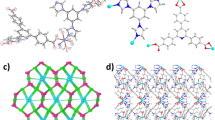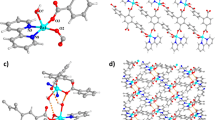Abstract
Two new Zn(II)-based coordination polymers {[Zn3(L1)6(H2O)]∙(H2O)4}n (1, HL1 = 4-(tetrazol-5-yl)phenyl-4,2′:6′,4″-terpyridine) and [Zn2Cl2(L2)2H2O]n (2, HL2 = 4-([2,2′:6’,2″’-terpyridin]-4′-yl)benzoic acid) have been successfully prepared using two similar organic ligands with distinct donor groups under similar reaction conditions. The distinct structural features and donor atoms make the two complexes show different water stability, and the complex 1 with good water stability, which can be utilized as the sensor for Fe3+ ion detection in water. The value of Stern–Volmer quenching constant of 1 to the Fe3+ is 5.77 × 104 M− 1, which lies in the top region of the reported CP-based sensors. The mechanism investigation reveals that the energy transfer of resonance from the complex 1 to the Fe3+ ion can account for its fluorescent quenching behavior. The treatment activity of compounds 1 and 2 on the postpartum hemorrhage (PPH) was assessed. First, the cytotoxicity of compounds 1 and 2 on human umbilical vein endothelial cells was assessed with Cell Counting Kit-8 detection kit. Then, to evaluate the prevention of compounds 1 and 2 on the PPH, we conducted the Lowry method and detected the clotting factor IX and anticoagulant factor III contents after the indicated treatment. Finally, the inflammatory response in mice was determined by ELISA method, and the IL-6 and IL-8 levels were determined.









Similar content being viewed by others
References
Kondoh E, Chigusa Y, Ueda A, Mogami H, Mandai M (2019) Uterine artery embolization versus cesarean hysterectomy in the Novel intrauterine balloon tamponade systems for postpartum hemorrhage. Acta Obstet Gyn Scan 98:1612–1617
van Ast M, Goedhart MM, Luttmer R, Orelio C, Deurloo KL, Veerbeek J (2019) The duration of the third stage in relation to postpartum hemorrhage. Birth (Berkeley Calif) 46:602–607
Kawakita T, Mokhtari N, Huang JC, Landy HJ (2019) Evaluation of risk-assessment tools for severe postpartum hemorrhage in women undergoing cesarean delivery. Obstet Gynecol 134:1308–1316
Tekela DD, Asmare AG, Gebremariam BM, Assegahegn CA, Wami KD, Nemomssa HD, Simegn GL (2019) Digital postpartum hemorrhage management device (DPHMD). BMC Pregnancy Childb 19:438
Feng X, Ling XL, Liu L, Wang LY, Ng SW, Su BY (2013) A series of 3D lanthanide frameworks constructed from aromatic multi-carboxylate ligand: Structural diversity, luminescence and magnetic properties. Dalton T 42:10292–10303
Feng X, Liu J, Li J, Ma LF, Wang LY, Ng SW, Qin GZ (2015) Series of coordination-polymers based on 4-(5-sulfo-quinolin-8-yloxy) phthalate and bipyridinyl coligands: structure diversity and properties. J Solid State Chem 80:230–236
Feng X, Feng YQ, Guo N, Sun YL, Zhang T, Ma LF, Wang LY (2017) Series d – f heteronuclear metal – organic frameworks: color tunability and luminescent probe with switchable properties. Inorg Chem 56:1713–1721
Zhang D, Wang MM, Jiang N, Liu Y, Yu XN, Zhang HB (2020) Electrochemical corrosion behavior of Ni-doped ZnO thin film coated on low carbon steel substrate in 3.5% NaCl solution. Int J Electrochem Sci 15:4117–4126
Du H, Ma C, Ma W, Wang H (2018) Microstructure evolution and dielectric properties of Ce-doped SrBi4Ti4O15Ceramics synthesized via glycine-nitrate process. Process Appl Ceram 12:303–312
Liu W, Li H, Zhu H, Xu P (2020) The interfacial adhesion performance and mechanism of a modified asphalt–steel slag aggregate. Materials 13:1180
Chen DM, Zhang XJ (2019) A Polyhedron-Based Metal-Organic Framework with a Rare Hexanuclear Co(II) Cluster for Selective Sorption and Chemical Conversion for CO2. J Solid State Chem 278:120906.
Zheng LN, Wei FH, Hu HM, Bai C, Yang XL, Wang X, Xue G (2019) Lanthanide coordination polymers constructed from the asymmetrical N-heterocyclic rigid carboxylate: Synthesis, crystal structures, luminescence properties and magnetic properties. Polyhedron 161:47–55
Li LJ, Liao PQ, He CT, Wei YS, Zhou HL, Lin JM, Li XY, Zhang JP (2015) Grafting alkylamine in UiO-66 by charge-assisted coordination bond for carbon dioxide capture from high-humidity flue gas. J Mater Chem A 3:21849–21855
Liu JJ, Xia SB, Duan YL, Liu T, Cheng FX, Sun CK (2018) Anion-controlled architecture and photochromism of naphthalene diimide-based coordination polymers. Polymers (Basel) 10:165
Shigematsu A, Yamada T, Kitagawa H (2012) Selective separation of water, methanol, and ethanol by a porous coordination polymer built with a flexible tetrahedral ligand. J Am Chem Soc 134:13145–13147
Li XF, Wang X, Wu YY, Zhao XW, Li HY, Li YM (2019) Four coordination polymers based on 4’-(4-carboxyphenyl)-2,2’:6’,2’’-terpyridine: Syntheses, structures and properties. J Solid State Chem 269:118–124
Zhao F, Dong ZP, Liu ZL, Wang YQ (2019) A new cobalt coordination framework based on trinuclear Co(II)-tetrazolate bridges and a terpyridine tetrazolate ligand: Synthesis and magnetism. Inorg Chem Commun 107:107465
Chen DM, Zhang XJ (2019) Stepwise and Hysteretic Sorption of CO2 in Polycatenated Metal-Organic Frameworks. Cryst Eng Comm 21:4696–4700
Wang Z, Shen YQ, Hao JF, Chen QF, Jin Y (2020) Two Zn(II) coordination polymers: Luminescent sensing property and treatment capacity against stable coronary heart disease by regulating E.coli abundance and IL-17 content. J Solid State Chem 287:121316
Acknowledgements
This work was supported by grants from Medical Research Project of Chongqing Health and Family Planning Commission (2017MSXM031).
Author information
Authors and Affiliations
Corresponding author
Additional information
Publisher's Note
Springer Nature remains neutral with regard to jurisdictional claims in published maps and institutional affiliations.
Rights and permissions
About this article
Cite this article
Wu, X., Wen, Y., Tan, XQ. et al. Two Zn(II)-based Coordination Polymers: Fe3+ Ion and Prevention Activity Detection On Postpartum Hemorrhage By Regulating Anticoagulant Factor Activity. J Fluoresc 30, 1365–1374 (2020). https://doi.org/10.1007/s10895-020-02619-7
Received:
Accepted:
Published:
Issue Date:
DOI: https://doi.org/10.1007/s10895-020-02619-7




